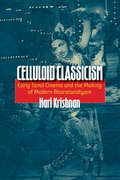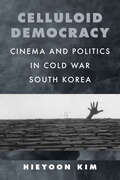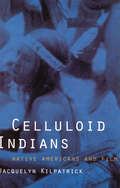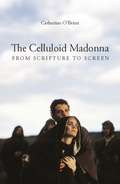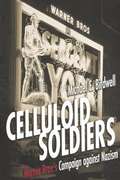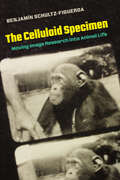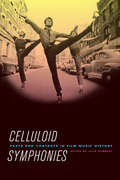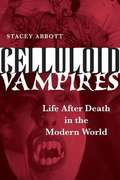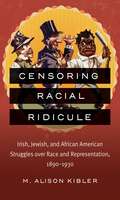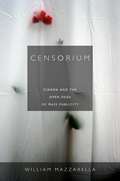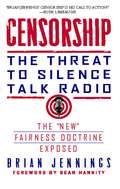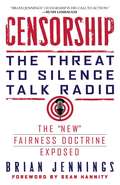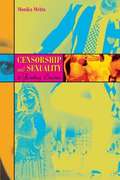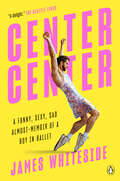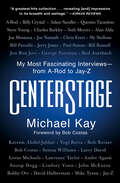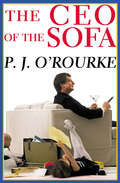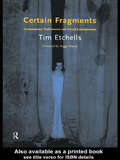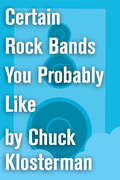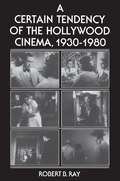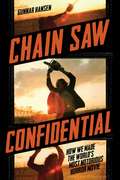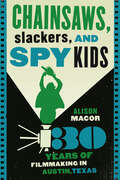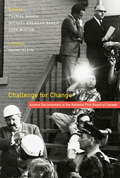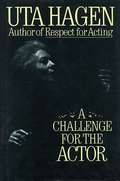- Table View
- List View
Celluloid Classicism: Early Tamil Cinema and the Making of Modern Bharatanatyam
by Hari KrishnanCelluloid Classicism provides a rich and detailed history of two important modern South Indian cultural forms: Tamil Cinema and Bharatanatyam dance. It addresses representations of dance in the cinema from an interdisciplinary, critical-historical perspective. The intertwined and symbiotic histories of these forms have never received serious scholarly attention. For the most part, historians of South Indian cinema have noted the presence of song and dance sequences in films, but have not historicized them with reference to the simultaneous revival of dance culture among the middle-class in this region. In a parallel manner, historians of dance have excluded deliberations on the influence of cinema in the making of the "classical" forms of modern India. Although the book primarily focuses on the period between the late 1920s and 1950s, it also addresses the persistence of these mid-twentieth century cultural developments into the present. The book rethinks the history of Bharatanatyam in the twentieth century from an interdisciplinary, transmedia standpoint and features 130 archival images.
Celluloid Democracy: Cinema and Politics in Cold War South Korea
by Hieyoon KimA free ebook version of this title is available through Luminos, University of California Press's Open Access publishing program. Visit www.luminosoa.org to learn more.Celluloid Democracy tells the story of the Korean filmmakers, distributors, and exhibitors who reshaped cinema in radically empowering ways through the decades of authoritarian rule that followed Korea's liberation from Japanese occupation. Employing tactics that ranged from representing the dispossessed on the screen to redistributing state-controlled resources through bootlegging, these film workers explored ideas and practices that simultaneously challenged repressive rule and pushed the limits of the cinematic medium. Drawing on archival research, film analysis, and interviews, Hieyoon Kim examines how their work foregrounds a utopian vision of democracy where the ruled represent themselves and access resources free from state suppression. The first book to offer a history of film activism in post-1945 South Korea, Celluloid Democracy shows how Korean film workers during the Cold War reclaimed cinema as an ecology in which democratic discourses and practices could flourish.
Celluloid Indians: Native Americans and Film
by Neva Jacquelyn KilpatrickNative American characters have been the most malleable of metaphors for filmmakers. The likeable Doc of Stagecoach (1939) had audiences on the edge of their seats with dire warnings about “that old butcher, Geronimo.” Old Lodgeskins of Little Big Man (1970) had viewers crying out against the demise of the noble, wise chief and his kind and simple people. In 1995 Disney created a beautiful, peace-loving ecologist and called her Pocahontas. Only occasionally have Native Americans been portrayed as complex, modern characters in films like Smoke Signals. Celluloid Indians is an accessible, insightful overview of Native American representation in film over the past century. Beginning with the birth of the movie industry, Jacquelyn Kilpatrick carefully traces changes in the cinematic depictions of Native peoples and identifies cultural and historical reasons for those changes. In the late twentieth century, Native Americans have been increasingly involved with writing and directing movies about themselves, and Kilpatrick places appropriate emphasis on the impact that Native American screenwriters and filmmakers have had on the industry. Celluloid Indians concludes with a valuable, in-depth look at influential and innovative Native Americans in today’s film industry.
The Celluloid Madonna: From Scripture to Screen (Wallflower Press Ser.)
by Catherine O'BrienThe Celluloid Madonna is the first book to analyze the life of the Virgin Mary on screen from the silent era through to the present. For decades, Mary has caught the imagination of filmmakers from a range of religious backgrounds, whether Catholic, Protestant, Muslim, Marxist, or atheist, and film's intersection of theology and secular culture has inspired some of the most singular and controversial visions of this icon in cinema history. Focusing on the challenge of adapting Scripture to the screen, this volume discusses Cecil B. DeMille's The King of Kings (1927), Pier Paolo Pasolini's The Gospel According to St. Matthew (1964), Franco Zeffirelli's Jesus of Nazareth (1977), Jean-Luc Godard's Hail Mary (1984), Jean Delannoy's Mary of Nazareth (1994), Mel Gibson's The Passion of the Christ (2004), Catherine Hardwicke's The Nativity Story (2006), and Mark Dornford-May's Son of Man (2006).
The Celluloid Madonna: From Scripture to Screen
by Catherine O'BrienThe Celluloid Madonna is the first book to analyze the life of the Virgin Mary on screen from the silent era through to the present. For decades, Mary has caught the imagination of filmmakers from a range of religious backgrounds, whether Catholic, Protestant, Muslim, Marxist, or atheist, and film's intersection of theology and secular culture has inspired some of the most singular and controversial visions of this icon in cinema history. Focusing on the challenge of adapting Scripture to the screen, this volume discusses Cecil B. DeMille's The King of Kings (1927), Pier Paolo Pasolini's The Gospel According to St. Matthew (1964), Franco Zeffirelli's Jesus of Nazareth (1977), Jean-Luc Godard's Hail Mary (1984), Jean Delannoy's Mary of Nazareth (1994), Mel Gibson's The Passion of the Christ (2004), Catherine Hardwicke's The Nativity Story (2006), and Mark Dornford-May's Son of Man (2006).
Celluloid Soldiers: Warner Bros.'s Campaign Against Nazism
by Michael E. Birdwell<p>During the 1930s many Americans avoided thinking about war erupting in Europe, believing it of little relevance to their own lives. Yet, the Warner Bros. film studio embarked on a virtual crusade to alert Americans to the growing menace of Nazism. <p>Polish-Jewish immigrants Harry and Jack Warner risked both reputation and fortune to inform the American public of the insidious threat Hitler's regime posed throughout the world. Through a score of films produced during the 1930s and early 1940s-including the pivotal Sergeant York-the Warner Bros. studio marshaled its forces to influence the American conscience and push toward intervention in World War II. <p>Celluloid Soldiers offers a compelling historical look at Warner Bros.'s efforts as the only major studio to promote anti-Nazi activity before the outbreak of the Second World War.</p>
The Celluloid Specimen: Moving Image Research into Animal Life
by Benjamin Schultz-FigueroaA free ebook version of this title is available through Luminos, University of California Press’s Open Access publishing program. Visit www.luminosoa.org to learn more. In The Celluloid Specimen, Benjamín Schultz‑Figueroa examines rarely seen behaviorist films of animal experiments from the 1930s and 1940s. These laboratory recordings—including Robert Yerkes's work with North American primate colonies, Yale University's rat‑based simulations of human society, and B. F. Skinner's promotions for pigeon‑guided missiles—have long been considered passive records of scientific research. In Schultz‑Figueroa's incisive analysis, however, they are revealed to be rich historical, political, and aesthetic texts that played a crucial role in American scientific and cultural history—and remain foundational to contemporary conceptions of species, race, identity, and society.
Celluloid Symphonies
by Julie HubbertCelluloid Symphonies is a unique sourcebook of writings on music for film, including essays by those who created the music: Max Steiner, Erich Korngold, Henry Mancini, Jerry Goldsmith, Elmer Bernstein and Howard Shore. Bringing together previously inaccessible critical documents, the book also describes the major trends and innovations that have shaped film music history from 1896 to the present. It outlines the important aesthetic choices, technological innovations, and commercial pressures that have consistently shaped the relationship between music and film. Julie Hubbert's introductory essays provide a stimulating overview of film history as well as critical context for the close study of these primary documents. In identifying documents that comprise a written and aesthetic history for film music, Celluloid Symphonies enriches the discourse of a broad community of film and music scholars and provides an astonishing resource to students.
Celluloid Vampires
by Stacey AbbottIn 1896, French magician and filmmaker George Méliès brought forth the first celluloid vampire in his film Le manoir du diable. The vampire continues to be one of film's most popular gothic monsters and in fact, today more people become acquainted with the vampire through film than through literature, such as Bram Stoker's classic Dracula. How has this long legacy of celluloid vampires affected our understanding of vampire mythology? And how has the vampire morphed from its folkloric and literary origins? In this entertaining and absorbing work, Stacey Abbott challenges the conventional interpretation of vampire mythology and argues that the medium of film has completely reinvented the vampire archetype. Rather than representing the primitive and folkloric, the vampire has come to embody the very experience of modernity. No longer in a cape and coffin, today's vampire resides in major cities, listens to punk music, embraces technology, and adapts to any situation. Sometimes she's even female. With case studies of vampire classics such as Nosferatu, Martin, Blade, and Habit, the author traces the evolution of the American vampire film, arguing that vampires are more than just blood-drinking monsters; they reflect the cultural and social climate of the societies that produce them, especially during times of intense change and modernization. Abbott also explores how independent filmmaking techniques, special effects makeup, and the stunning and ultramodern computer-generated effects of recent films have affected the representation of the vampire in film.
Censoring Racial Ridicule
by M. Alison KiblerA drunken Irish maid slips and falls. A greedy Jewish pawnbroker lures his female employee into prostitution. An African American man leers at a white woman. These and other, similar images appeared widely on stages and screens across America during the early twentieth century. In this provocative study, M. Alison Kibler uncovers, for the first time, powerful and concurrent campaigns by Irish, Jewish and African Americans against racial ridicule in popular culture at the turn of the twentieth century. Censoring Racial Ridicule explores how Irish, Jewish, and African American groups of the era resisted harmful representations in popular culture by lobbying behind the scenes, boycotting particular acts, and staging theater riots. Kibler demonstrates that these groups' tactics evolved and diverged over time, with some continuing to pursue street protest while others sought redress through new censorship laws. Exploring the relationship between free expression, democracy, and equality in America, Kibler shows that the Irish, Jewish, and African American campaigns against racial ridicule are at the roots of contemporary debates over hate speech.
Censorium: Cinema and the Open Edge of Mass Publicity
by William MazzarellaIn the world of globalized media, provocative images trigger culture wars between traditionalists and cosmopolitans, between censors and defenders of free expression. But are images censored because of what they mean, what they do, or what they might become? And must audiences be protected because of what they understand, what they feel, or what they might imagine? At the intersection of anthropology, media studies, and critical theory, Censorium is a pathbreaking analysis of Indian film censorship. The book encompasses two moments of moral panic: the consolidation of the cinema in the 1910s and 1920s, and the global avalanche of images unleashed by liberalization since the early 1990s. Exploring breaks and continuities in film censorship across colonial and postcolonial moments, William Mazzarella argues that the censors' obsessive focus on the unacceptable content of certain images and the unruly behavior of particular audiences displaces a problem that they constantly confront yet cannot directly acknowledge: the volatile relation between mass affect and collective meaning. Grounded in a close analysis of cinema regulation in the world's largest democracy, Censorium ultimately brings light to the elusive foundations of political and cultural sovereignty in mass-mediated societies.
Censorship
by Sean Hannity Brian JenningsFreedom of speech. It is our most cherished privilege as Americans, guaranteed by the First Amendment to the U.S. Constitution since 1791. But our current presidential administration threatens to sharply curtail or silence altogether the freedom of expression that distinguishes America from the average dictatorship. What is under direct attack? Conservative talk radio. During the Reagan administration, conservative talk radio burgeoned when the FCC voted to stop enforcing the Fairness Doctrine, which required all licensed broadcasters to present "balanced" viewpoints on controversial issues. The format was a smash hit, attracting an estimated 50 million listeners weekly. Popular, profitable, outspoken, powerful, influential--it's what the American people wanted, and its success was the Democrats' worst nightmare. Now, the principles underlying the Fairness Doctrine threaten to be reinstated. Under cover of being "fair," they will be used as a means of censorship, allowing government to influence who owns our airwaves and thus controls the content, a mandate with far-reaching implications for all media--indeed, for freedom of speech for all Americans.
Censorship: The Threat to Silence Talk Radio
by Brian Jennings Sean Hannity"Talk radio is the American voter." -- Rush Limbaugh Freedom of speech. It is our most cherished privilege as Americans, guaranteed by the First Amendment to the U. S. Constitution since 1791. But at the dawn of a new presidential administration, an epic battle is looming -- a battle for our airwaves that could sharply curtail or silence altogether the freedom of expression that distinguishes America from the average dictatorship. The target of this battle is conservative talk radio. If key Democrats have their way, the principles of the Federal Communications Commission's Fairness Doctrine will once again be enforced and allow government to control the content heard on free radio, a mandate that will have far-reaching implications for all media. During the Reagan administration the FCC voted to stop enforcing the Fairness Doctrine, which required all licensed broadcasters to present "balanced" viewpoints on controversial issues. Conservative talk radio burgeoned, giving rise to the father of conservative talk, Rush Limbaugh, and such hosts as Sean Hannity, Mark Levin, Michael Medved, Neal Boortz, Laura Ingraham, and others. The format was a smash hit -- resonating with listeners from coast to coast and giving a powerful voice to the conservative movement. Soon such programming, attracting an estimated 50 million listeners weekly, dominated the airwaves where liberal talk radio failed. Popular, profitable, outspoken, powerful, influential -- it's what the American people wanted, and its success was the Democrats' worst nightmare. Now, the principles of the Fairness Doctrine threaten to be reinstated -- if not directly, then through back-door tactics involving ownership of stations. Under cover of being "fair," they will prove to be anything but: They will be used as a means of censorship by those with contempt for conservative talk radio. With our current Congress firmly under Democratic control, the future of talk radio -- indeed, freedom of speech for all Americans -- is under direct attack.
Censorship and Sexuality in Bombay Cinema
by Monika MehtaIndia produces an impressive number of films each year in a variety of languages. Here, Monika Mehta breaks new ground by analyzing Hindi films and exploring the censorship of gender and heterosexuality in Bombay cinema. She studies how film censorship on various levels makes the female body and female sexuality pivotal in constructing national identity, not just through the films themselves but also through the heated debates that occur in newspapers and other periodicals. The standard claim is that the state dictates censorship and various prohibitions, but Mehta explores how relationships among the state, the film industry, and the public illuminate censorship's role in identity formation, while also examining how desire, profits, and corruption are generated through the act of censoring. Committed to extending a feminist critique of mass culture in the global south, Mehta situates the story of censorship in a broad social context and traces the intriguing ways in which the heated debates on sexuality in Bombay cinema actually produce the very forms of sexuality they claim to regulate. She imagines afresh the theoretical field of censorship by combining textual analysis, archival research, and qualitative fieldwork. Her analysis reveals how central concepts of film studies, such as stardom, spectacle, genre, and sound, are employed and (re)configured within the ambit of state censorship, thereby expanding the scope of their application and impact.
Center Center: A Funny, Sexy, Sad Almost-Memoir of a Boy in Ballet
by James Whiteside&“James Whiteside is an electrifying performer, an incredible athlete, and an artist, through and through. To know James is to love him; with Center Center, you are about to fall in love.&” —Jennifer Garner &“A frank examination and celebration of queerness.&”—Good Morning America A daring, joyous, and inspiring memoir-in-essays from the American Ballet Theatre principal dancer-slash-drag queen-slash-pop star who's redefining what it means to be a man in balletThere's a mark on every stage around the world that signifies the center of its depth and width, called "center center." James Whiteside has dreamed of standing on that very mark as a principal dancer with the prestigious American Ballet Theatre ever since he was a twelve-year-old blown away by watching the company's spring gala. The GLAMOUR. The VIRTUOSITY. The RIPPED MEN IN TIGHTS! In this absurd and absurdist collection of essays, Whiteside tells us the story of how he got to be a primo ballerino—stopping along the way to muse about the tragically fated childhood pets who taught him how to feel, reminisce on ill-advised partying at summer dance camps, and imagine fantastical run-ins with Jesus on Grindr. Also in these pages are tales of the two alter egos he created to subvert the strict classical rigor of ballet: JbDubs, an out-and-proud pop musician, and Ühu Betch, an over-the-top drag queen named after Yoohoo chocolate milk. Center Center is an exuberant behind-the-scenes tour of Whiteside&’s triple life, both on- and offstage—a raunchy, curious, and unapologetic celebration of queerness, self-expression, friendship, sex, creativity, and pushing boundaries that will entertain you, shock you*, inspire you, embolden you . . . and maybe even make you cry.*THIS IS NOT A BOOK FOR CHILDREN.
CenterStage: My Most Fascinating Interviews—from A-Rod to Jay-Z
by Michael KayFrom the longtime host of the New York Yankees&’ television broadcasts, ESPN Radio&’s The Michael Kay Show, and YES Network&’s Emmy Award–winning CenterStage comes a selection of his most memorable interviews with the most intriguing personalities in sports and entertainment—ranging from Jay-Z to Mike Tyson to Serena Williams to Adam Sandler to Bon Jovi to Larry David. Emmy Award–winning television announcer and interviewer Michael Kay&’s eighteen years as host of CenterStage have given him access to many remarkable figures in sports and entertainment. Now, this absorbing selection of the best, most revealing—and often surprising—interviews are available in one amazing collection, including some of the behind-the-scenes stories that didn&’t appear on camera. From Kay&’s very first CenterStage interview in 2001 with quarterback Steve Young, the show&’s creators knew they had something special. Kay&’s ability to get celebrities and otherwise private personalities to open up and share candid insights has become his trademark. Among the interviews featured in the book are those with Red Auerbach, Charles Barkley, Mike Tyson, Bobby Orr, Sly Stallone, Jay-Z, Lorne Michaels, Paul Simon, John McEnroe, Rob Reiner, Seth Meyers, Serena Williams, Alan Alda, David Halberstam, Larry David, Bob Costas, Billy Crystal, Lindsey Vonn, Chris Evert, and Quentin Tarantino. For any pop culture fan or sports enthusiast, this prized collection is one to cherish for generations.
The CEO of the Sofa
by P. J. O'RourkeExperience a year in the life of a cranky couch potato—also known as &“the funniest writer in America&” (The Wall Street Journal). Touching on topics from technological change to the United Nations, this is a chronicle of the day-to-day home life and frequent harangues of a New York Times–bestselling humorist. Over the course of the year, in between rants, he does occasionally leave the sofa and embark on exotic adventures—including a blind (drunk) wine tasting with Christopher Buckley, and a Motel 6 where he has twenty-eight channels and a bathroom to himself. As readers of Parliament of Whores, Give War a Chance, and his other bestsellers know, P. J. O&’Rourke takes no prisoners—though he may take a few naps. &“An entertaining and engaging read.&” —Associated Press &“A wide-angled worldview from his own living room, his salon of sarcasm. He introduces readers to his assistant, friends, family and smart-aleck babysitter . . . His vitriolic wit is couched in humor that elicits the gamut from giggles to guffaws.&” —Publishers Weekly
Certain Fragments: Texts and Writings on Performance
by Tim EtchellsWhat is the relationship between performance and play? Between performance and technology? Between performance and death? Certain Fragments is an extraordinary exploration of what lies at the heart of contemporary theatre. Written by the artistic director of Forced Entertainment, acknowledged to be Britains most brilliant experimental theatre company (Guardian), Certain Fragments investigates the processes of devising performance, the role of writing in an interdisciplinary theatre, and the influence of the city on contemporary art practice. Tim Etchells unique and provocative voice shifts from intimate anecdote to critical analysis and back again. And as in his theatre-making so in his book: with Certain Fragments Etchells disrupts traditional notions of creative, academic, and intellectual work. The book is an exciting and radical fusion of story-telling and criticism. It also makes available, for the first time, four seminal Forced Entertainment texts by Etchells.
Certain Rock Bands You Probably Like
by Chuck KlostermanOriginally collected in Chuck Klosterman IV and now available both as a stand-alone essay and in the collection Chuck Klosterman on Pop, this essay is about underrated and overrated artists.
A Certain Tendency of the Hollywood Cinema, 1930-1980
by Robert B. RayRobert B. Ray examines the ideology of the most enduringly popular cinema in the world--the Hollywood movie. Aided by 364 frame enlargements, he describes the development of that historically overdetermined form, giving close readings of five typical instances: Casablanca, It's a Wonderful Life, The Man Who Shot Liberty Valance, The Godfather, and Taxi Driver. Like the heroes of these movies, American filmmaking has avoided commitment, in both plot and technique. Instead of choosing left or right, avant-garde or tradition, American cinema tries to have it both ways.Although Hollywood's commercial success has led the world audience to equate the American cinema with film itself, Hollywood filmmaking is a particular strategy designed to respond to specific historical situations. As an art restricted in theoretical scope but rich in individual variations, the American cinema poses the most interesting question of popular culture: Do dissident forms have any chance of remaining free of a mass medium seeking to co-opt them?
Chain Saw Confidential
by Gunnar HansenWhen The Texas Chain Saw Massacre first hit movie screens in 1974 it was both reviled and championed. To critics, it was either "a degrading, senseless misuse of film and time" or "an intelligent, absorbing and deeply disturbing horror film." However it was an immediate hit with audiences. Banned and celebrated, showcased at the Cannes film festival and included in the New York MoMA's collection, it has now come to be recognized widely as one of the greatest horror movies of all time.A six-foot-four poet fresh out of grad school with limited acting experience, Gunnar Hansen played the masked, chain-saw-wielding Leatherface. His terrifying portrayal and the inventive work of the cast and crew would give the film the authentic power of nightmare, even while the gritty, grueling, and often dangerous independent production would test everyone involved, and lay the foundations for myths surrounding the film that endure even today.Critically-acclaimed author Hansen here tells the real story of the making of the film, its release, and reception, offering unknown behind-the-scenes details, a harrowingly entertaining account of the adventures of low-budget filmmaking, illuminating insights on the film's enduring and influential place in the horror genre and our culture, and a thoughtful meditation on why we love to be scared in the first place.
Chainsaws, Slackers and Spy Kids: 30 Years of Filmmaking in Austin, Texas
by Alison MacorDuring the 1990s, Austin achieved “overnight” success and celebrity as a vital place for independent filmmaking. Directors Richard Linklater and Robert Rodriguez proved that locally made films with regional themes such as Slacker and El Mariachi could capture a national audience. Their success helped transform Austin’s homegrown film community into a professional film industry staffed with talented, experienced filmmakers and equipped with state-of-the art-production facilities. Today, Austin struggles to balance the growth and expansion of its film community with an ongoing commitment to nurture the next generation of independent filmmakers. Chainsaws, Slackers, and Spy Kids chronicles the evolution of this struggle by re-creating Austin’s colorful movie history. Based on revealing interviews with Richard Linklater, Robert Rodriguez, Mike Judge, Quentin Tarantino, Matthew McConaughey, George Lucas, and more than one hundred other players in the local and national film industries, Alison Macor explores how Austin has become a proving ground for contemporary independent cinema. She begins in the early 1970s with Tobe Hooper’s horror classic, The Texas Chainsaw Massacre, and follows the development of the Austin film scene through 2001 with the production and release of Rodriguez’s $100-million blockbuster, Spy Kids. Each chapter explores the behind-the-scenes story of a specific movie, such as Linklater’s Dazed and Confused and Judge’s Office Space, against the backdrop of Austin’s ever-expanding film community.
Challenge for Change: Activist Documentary at the National Film Board of Canada
by Thomas Waugh Michael Brendan Baker Ezra WintonPioneering participatory, social change-oriented media, the program had a national and international impact on documentary film-making, yet this is the first comprehensive history and analysis of its work. The volume's contributors study dozens of films produced by the program, their themes, aesthetics, and politics, and evaluate their legacy and the program's place in Canadian, Québécois, and world cinema. An informative and nuanced look at a cinematic movement, Challenge for Change reemphasizes not just the importance of the NFB and its programs but also the role documentaries can play in improving the world.
Challenge for Change
by Thomas Waugh Ezra Winton Michael Brendan BakerPioneering participatory, social change-oriented media, the program had a national and international impact on documentary film-making, yet this is the first comprehensive history and analysis of its work. The volume's contributors study dozens of films produced by the program, their themes, aesthetics, and politics, and evaluate their legacy and the program's place in Canadian, Québécois, and world cinema. An informative and nuanced look at a cinematic movement, Challenge for Change reemphasizes not just the importance of the NFB and its programs but also the role documentaries can play in improving the world.
A Challenge for the Actor
by Uta HagenIt takes talent, TALENT is defined in the dictionary as "the natural endowment of a person with special or creative aptitudes."
